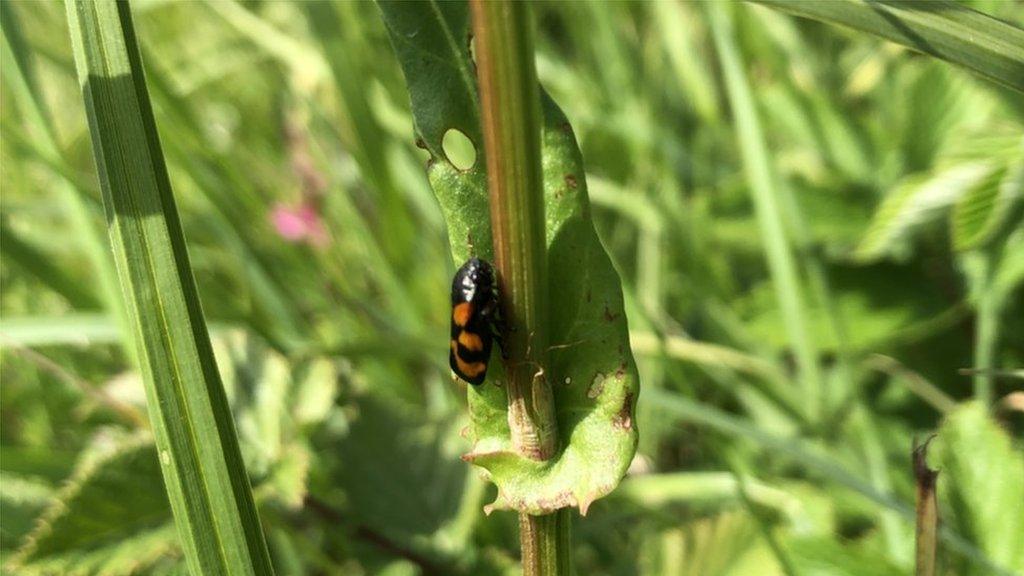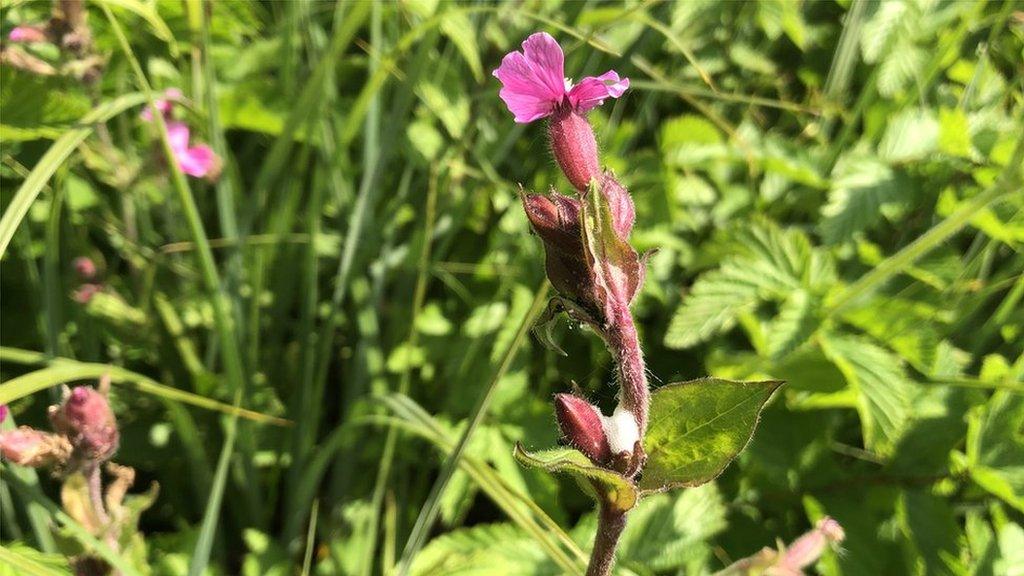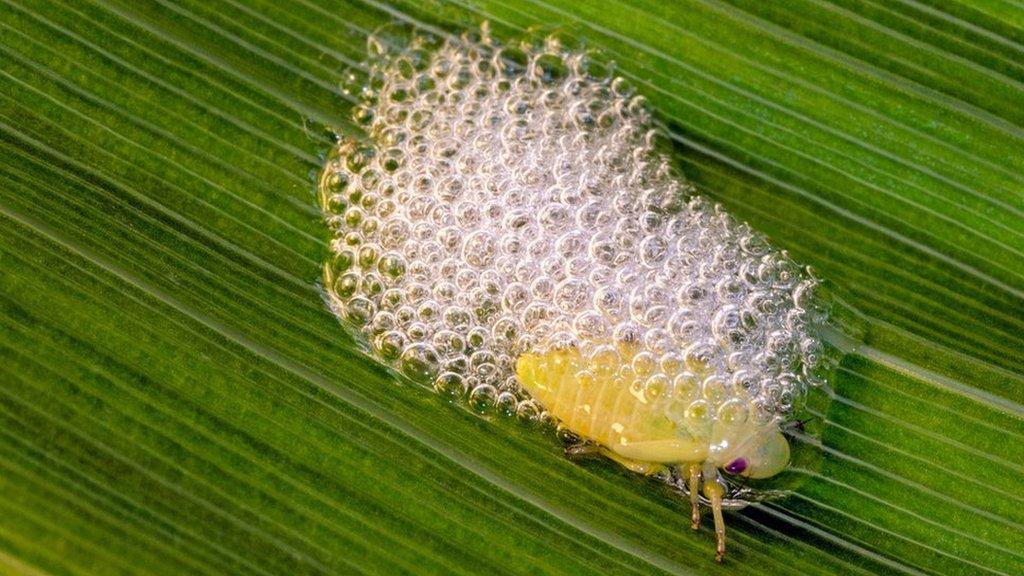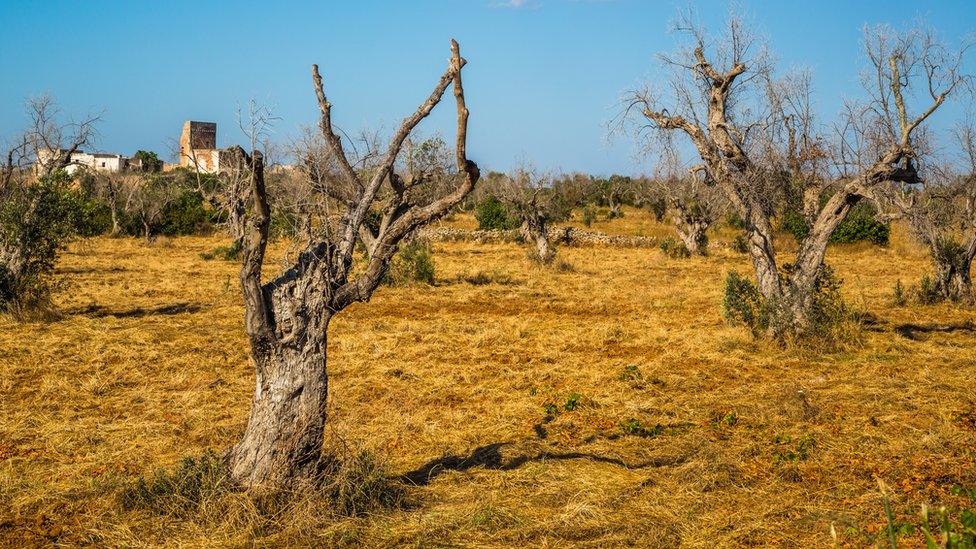Bug hunt: Volunteers needed to spot insect's 'spittle'
- Published
Scientists want your help tracking spittlebugs.
Ever seen a blob of foam on a plant and wondered how it got there?
The frothy spittle, sometimes called cuckoo spit, is actually a telltale sign that an insect known as the spittlebug is feeding on a plant.
Scientists are calling for thousands of volunteers to help record sightings of spittle and spittlebugs across the UK.
The information will be used to map the distribution of the insect, in a pre-emptive strike against a deadly plant disease.
Xylella has struck several EU countries, blighting olive groves in southern Italy. The UK is clear of the disease but is on high alert.

The red-and-black spittlebug, which hatches out on plant roots and appears earlier in the year
There are a huge number of plants the Xylella bacterium could affect, from garden plants like the rosemary and lavender to the oak, said Dr Rebekah Robinson, senior plant pathologist at the Royal Horticultural Society.
"Xylella has 563 different host plants worldwide, so it affects a huge range of different species," she told BBC News.
"One of the really devastating things that could happen is that it could actually affect our native tree species as well, things like oak trees, a number of different ash species, sycamore - key plants in our landscape."
Scientists are calling for volunteers to record where and when they've seen spittle or spittlebugs, in gardens, meadows, grasslands and woodlands.

Red-and-black spittlebug at the Sussex Wildlife Trust's Woods Mill Nature Reserve

Spittle on a meadow flower at the reserve

Facts about the spittlebug
Small, sap-sucking insects which are also known as froghoppers
Can be found in UK gardens, meadows, grasslands and woodlands from April to late June
The most common species in the UK is the meadow spittlebug (Philaenus spumarius). Adults are 0.5cm long and vary in pattern and colour from pale brown to black and can jump many times their body length
The red-and-black spittlebug hatches out on the roots of plants, rather than in blobs of spittle on plant stems
There are ten species of spittlebug in the UK and the young - called nymphs - all produce whitish, frothy blobs of spittle on leaves and branches.
Source: RHS


Spittlebug nymph on leaf
The results will be used to map the distribution of the insect to better understand how Xylella might enter and spread in the UK.
Dr Alan Stewart, Reader of Ecology at the University of Sussex said we need to learn as much as we possibly can about what kinds of plants they feed on, what habitats they occupy, and where they are in the country.
"So, ultimately, if the worst possible happens, and the disease does arrive in Britain, we'll be able to make some really good predictions about how it's likely to spread and how quickly."
The spittlebugs are not pests in themselves and do not damage plants, said Dr Robinson.
"We don't want you to go round squishing the spittlebugs, but we do want to understand where they're living," she added.
What is Xylella?
Xylella fastidiosa arrived in Europe six years ago, devastating olive groves in southern Italy and spreading to other countries in the EU, including parts of France and Spain.

Olive trees killed by the disease in Italy
The disease is caused by a bacterium which is moved from one plant to another by plant-sucking insects such as the spittlebug.
Other stories you might like:
According to experts, Xylella is one of the most dangerous pathogens worldwide.
If found in the UK, all host plants within 100m would need to be destroyed and there would be immediate movement restrictions on some plants within a 5km radius for up to five years.
You can report sightings at https://www.brc.ac.uk/irecord/xylem-feeding-insects, external.
Further information about the survey and the insects can be found here, external.
Please note that it may take some time to access the links to report sightings due to a high volume of traffic.
Follow Helen on Twitter, external.